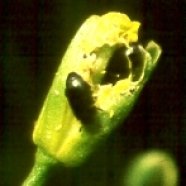Resistance of pollen beetle and stem pests against pyrethroid containing insecticides in Bavaria

Rape stem weevil, cabbage stem weevil and pollen beetle are the relevant spring pests in oilseed rape crops in Bavaria. The efficiency of oilseed rape cultivation essentially depends on the successful control of theses insect pests. But the existing standard insecticides containing pyrethroids can hardly take control of the pollen beetle anymore.
Pyrethroids loose their effect
For years insecticides from pyrethroide group class II (Decis liquid, Karate Zeon, Sumicidin Alpha EC et al.) were the standard products for the control of oil seed rape pests. Since 2003 reports about insufficient effects of these insecticides on pollen beetles accumulate. In 2004 the first case of resistance was confirmed in a laboratory in Upper Palatinate. A monitoring realised by the official Bavarian Plant Protection Service last year showed that meanwhile the resistance increased from year to year and by now exists in all of our producing areas.
The pollen beetle hibernates as beetle in the top soil layer in the outskirts of woods or in hedges. In early spring (about the same time as stem pests) the animals leave their wintering grounds and in fine, sunny weather they fly into oilseed rape crops. A typical feature of the 1.5 – 2.5 mm small, black beetle is the metallic (greenish to bluish) shining elytrons. They mainly feed on protein rich pollen. As the flowers of the oilseed rape are still closed at the time of the arrival of the beetles they bite holes into the buds to get at the pollen. The damaged buds have holes in different sizes and fall off later on. Empty pedicels and possibly malformed pods (siliquas) are left over. From the start of the flowering period the beetles usually take the more comfortable route to their food and damage is reduced. With massive occurrence of beetles these “feeding grounds” are not enough and – as observations from 2006 show –not yet open buds are heavily damaged even in crops that are in flower. After maturation feeding female beetles bite a small hole into the receptacle and deposit their eggs at the stamen and pistil. After a few days the larvae eclose and also feed on pollen, but scarcely damage the oilseed rape plants in the process. After three to four weeks the larvae drop to the ground to pupate. Young beetles appear from June on and perform maturation feeding stages on different flowering plants before they fly to their wintering grounds in the outskirts of woods starting end of August.



